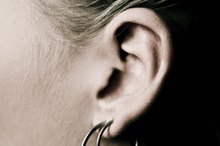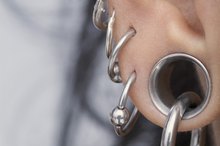How to Treat an Infected Belly-Button Piercing
Belly button piercing infections are not common if you follow the instructions from your piercer and have your piercing done by a professional who is a member of the Association of Professional Piercers. Still, localized piercing infections can happen, and it's important to treat it promptly to prevent it from spreading or getting worse.
How to Tell if Your Belly-Button Piercing Infected
After getting a piercing, it’s common for there to be redness, irritation and light-colored discharge at the site. But if those symptoms continue for more than a week and worsen, you could have an infection. Some warning signs that your piercing is infected:
- persistent pain, swelling, redness and warmth at the piercing site - thick, dark-colored discharge - fever, chills, nausea - red streaks that radiate out from the infection site
However, some people may experience an allergic reaction to the metal of the piercing. Certain metals, such as nickel, copper and low-grade gold (gold mixed with metal alloys), can spark an allergic reaction. Here are some warning signs you’re experiencing an allergic reaction:
- intermittent tenderness at the piercing site - redness, itchy rash around the piercing - blisters
If you do experience these symptoms, contact your piercer and ask if they can swap out your piercing. Make sure your piercing is made out of 14- or 18-karat gold, surgical steel, sterling silver, platinum or labeled “hypoallergenic.”
If your piercing is infected, here are some easy steps to treat the infection at home.
It may seem counter-intuitive, but the first thing you should NOT do is take the piercing out. Taking the jewelry out can cause the hole to close up and trap the infection inside, which can create an abscess below your skin. Keeping the piercing in keeps the hole in and allows pus to drain out.
- After getting a piercing, it’s common for there to be redness, irritation and light-colored discharge at the site.
- Here are some warning signs you’re experiencing an allergic reaction: - intermittent tenderness at the piercing site - redness, itchy rash around the piercing - blisters If you do experience these symptoms, contact your piercer and ask if they can swap out your piercing.
Leave Your Belly-Button Piercing IN
How to Clear Up Infected Pierced Ears
Learn More
Before you touch the piercing or piercing site, wash your hands thoroughly. To prevent and treat an infection, you should clean your belly-button piercing with warm water and soap twice daily. Avoid using alcohol, hydrogen peroxide or harsh soaps. Switch to a milder soap if you notice red bumps around the navel area and experience tenderness.
After cleaning, pat the area dry with a paper towel. Don’t scrub the piercing site with a washcloth or rub it dry with a towel. The piercing could catch on the cloth and scrubbing could spread the infection. Avoid over cleaning, since this can irritate the skin.
Clean the Piercing Site Daily
Apply a wet, warm washcloth to the infected site to encourage pus to drain. Don’t use an antibacterial ointment -- this can trap the infection at the site and delay the healing process.
Use a Warm Compress
How to Prevent Infection in Pierced Ears
Learn More
If your symptoms don’t clear up after 48 hours or if they worsen, make sure you reach out to your piercer or doctor. Your doctor can prescribe a cream or gel that contains mupirocin, an antibiotic, to help get rid of the infection.
Consult Your Piercer or a Doctor
How to Prevent Future Piercing Infections
To prevent an infection from occurring or reoccurring at the piercing site, it's important to follow a few key steps:
- Keep the piercing clean and dry. - Wear loose clothing until your belly-button piercing heals to avoid chafing or irritation. - Avoid touching your piercing unless necessary to keep bacteria from your hands transferring to the piercing site. - Check the site daily for unusual irritation or redness. - Shower, don’t bathe. Soaking in bathwater could transfer bacteria to the piercing site.
Signs of Infection
- persistent pain, swelling, redness and warmth at the piercing site - thick, dark-colored discharge - fever, chills, nausea - red streaks that radiate out from the infection site
-
- persistent pain, swelling, redness and warmth at the piercing site - thick, dark-colored discharge - fever, chills, nausea - red streaks that radiate out from the infection site To prevent an infection from occurring or reoccurring at the piercing site, it's important to follow a few key steps: - Keep the piercing clean and dry.
- persistent pain, swelling, redness and warmth at the piercing site - thick, dark-colored discharge - fever, chills, nausea - red streaks that radiate out from the infection site To prevent an infection from occurring or reoccurring at the piercing site, it's important to follow a few key steps: - Keep the piercing clean and dry.
-
- Avoid touching your piercing unless necessary to keep bacteria from your hands transferring to the piercing site.
- Avoid touching your piercing unless necessary to keep bacteria from your hands transferring to the piercing site.
- -
Related Articles
References
- Holbrook J, Minocha J, Laumann A. Body piercing: complications and prevention of health risks. Am J Clin Dermatol. 2012;13(1):1-17. doi:10.2165/11593220-000000000-00000
- Antoszewski B, Jedrzejczak M, Kruk-Jeromin J. Complications after body piercing in patient suffering from type 1 diabetes mellitus. Int J Dermatol. 2007;46(12):1250-1252. doi:10.1111/j.1365-4632.2007.03372.x
- Madu P, Kundu RV. Follicular and scarring disorders in skin of color: presentation and management. Am J Clin Dermatol. 2014;15(4):307-321. doi:10.1007/s40257-014-0072-x
- Holbrook J, Minocha J, Laumann A. Body piercing: complications and prevention of health risks. Am J Clin Dermatol. 2012;13(1):1-17. doi:10.2165/11593220-000000000-00000
- University of Michigan. Body art: What you need to know before getting a tattoo or piercing. University Health Service. 2019.
- Meltzer DI. Complications of body piercing. Am Fam Physician. 2005;72(10):2029-2034.
- Antoszewski B, Jedrzejczak M, Kruk-Jeromin J. Complications after body piercing in patient suffering from type 1 diabetes mellitus. Int J Dermatol. 2007;46(12):1250-1252. doi:10.1111/j.1365-4632.2007.03372.x
- Madu P, Kundu RV. Follicular and scarring disorders in skin of color: presentation and management. Am J Clin Dermatol. 2014;15(4):307-321. doi:10.1007/s40257-014-0072-x
- Weber, Angela. "Evaluation of Potential Bloodborne Pathogen." (PDF) Feb 2001. Centers for Disease Control and Prevention.
Resources
Writer Bio
Amanda Knaebel is a self-professed gadget geek and loves all things tech, both new and old. Amanda has been working as a freelance writer for over 10 years on topics including technology, health, fitness, nutrition, gardening and many more. She has also worked with Fortune 50 tech and financial companies, both in technical support and content production.









